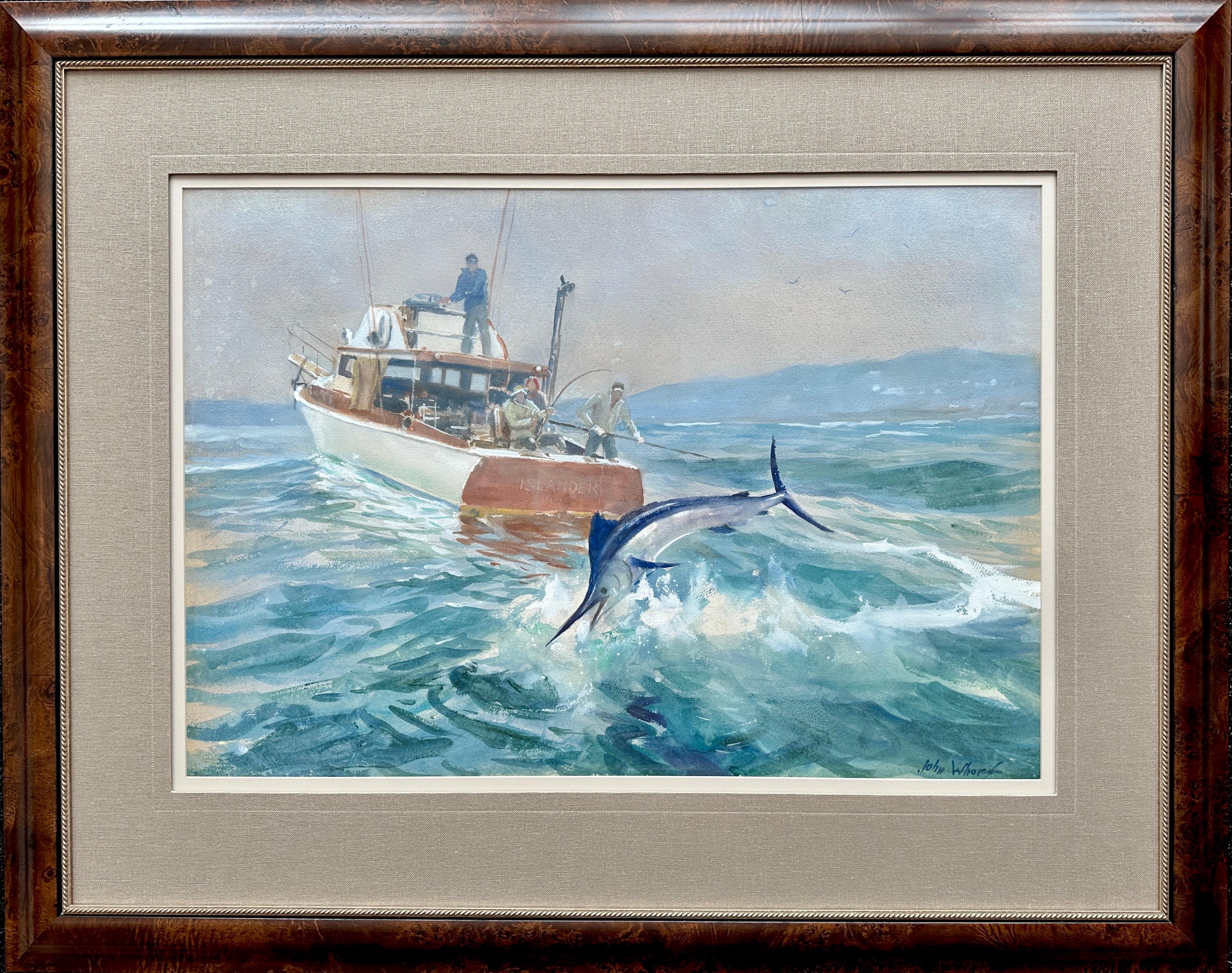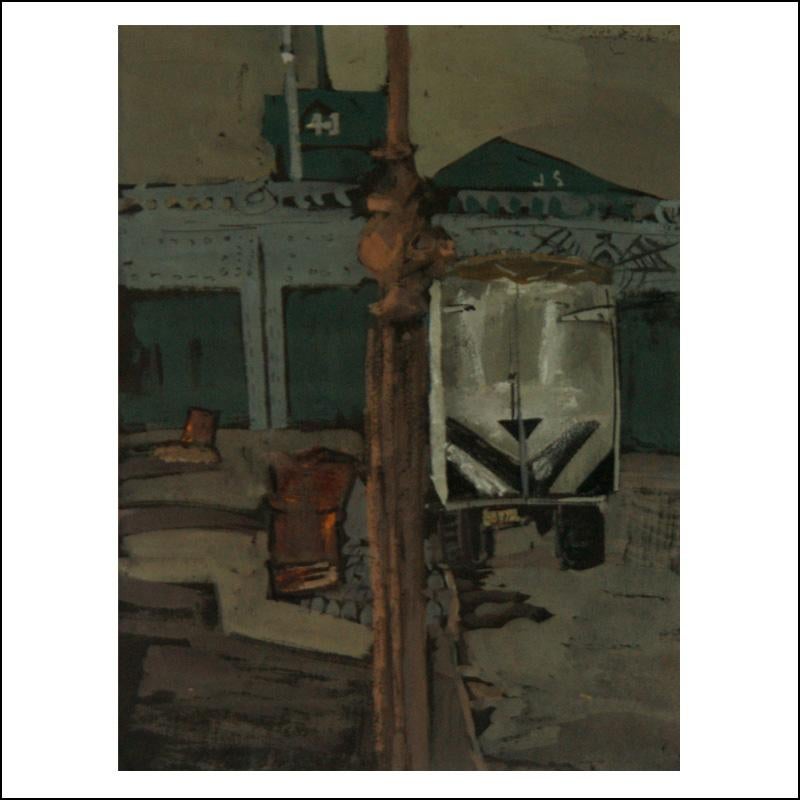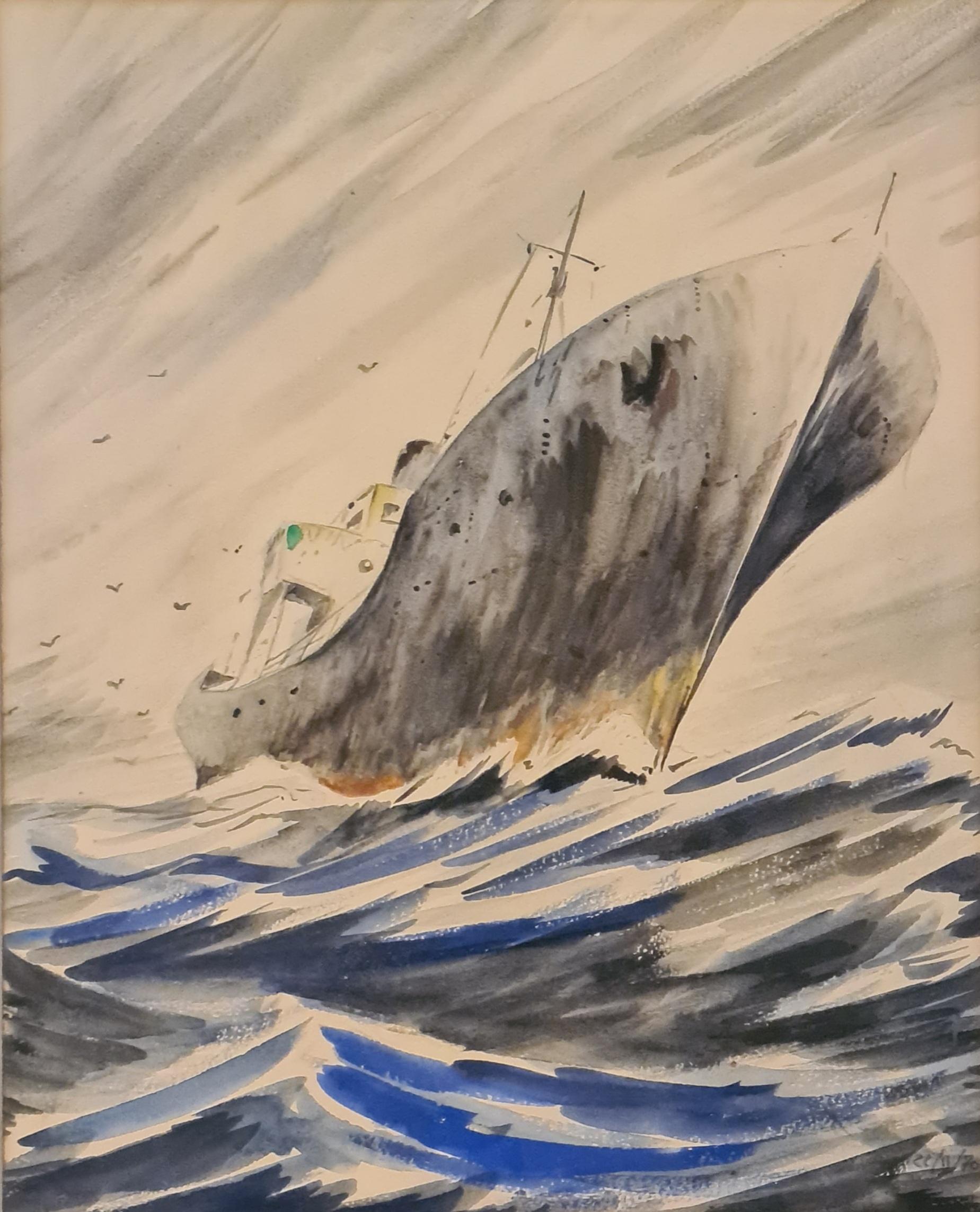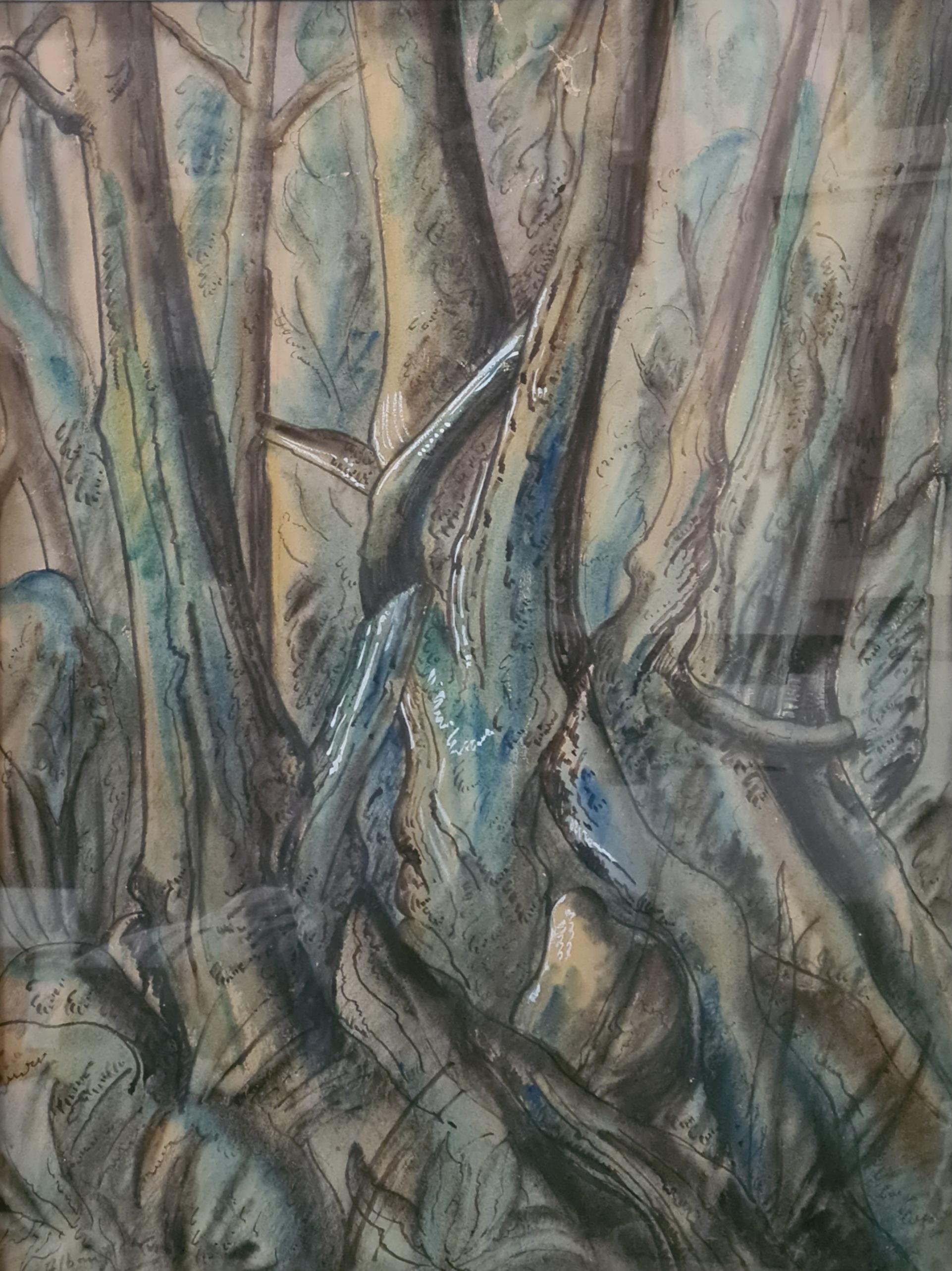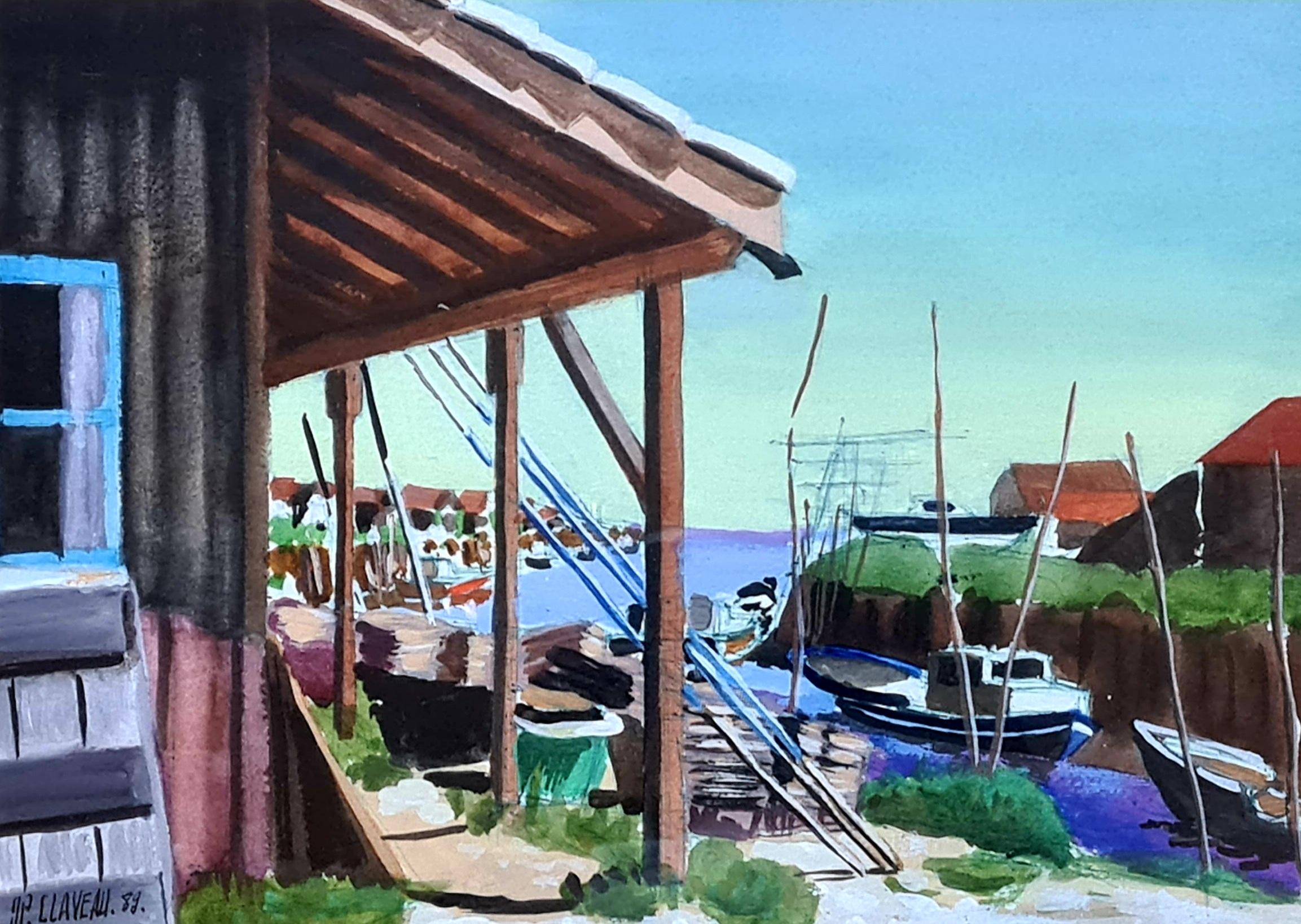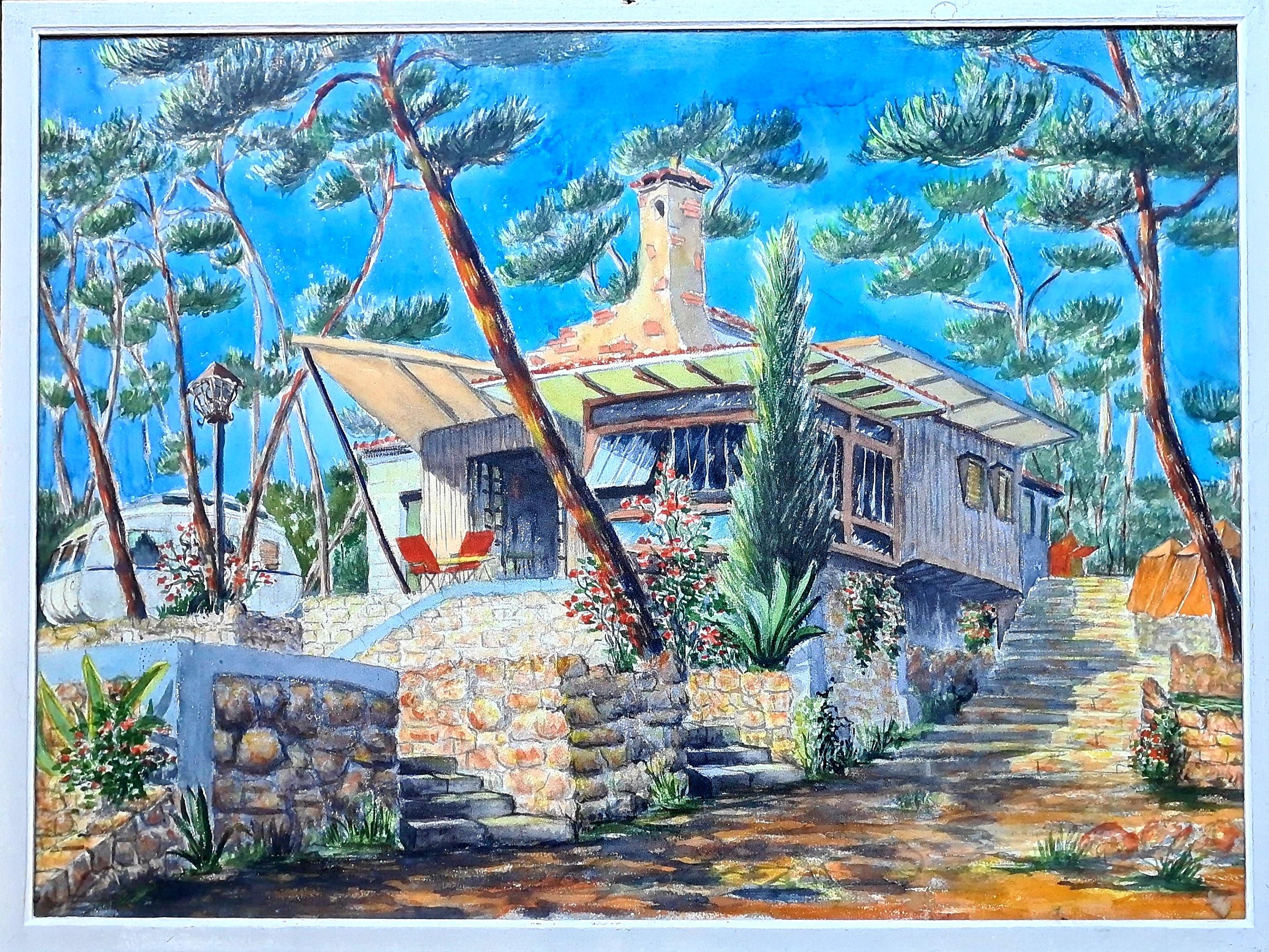Items Similar to Israeli Modernist Old City Jerusalem Landscape Folk Art Watercolor Painting
Want more images or videos?
Request additional images or videos from the seller
1 of 6
Zvi EhrmanIsraeli Modernist Old City Jerusalem Landscape Folk Art Watercolor Painting
About the Item
In this piece the artist choice of colors is vibrant, and there is minimal blending of them. The artist takes a naive, Folk Art approach at rendering the subject simplifying the figures to basic geometric shapes.
Krakow, Poland, 1903 – Safed, Israel, 1993
Zvi Ehrman was a talented aquarellist who focused his work on Jewish subjects and landscape to Israel. He studied at the Art Academy of Krakow and taught art at the Hebrew Gymnasium in Krakow. He moved to Israel and became a prominent figure in the artist colony in Safed. Ehrman´s works are figurative and use soft pastel tones to capture the brilliance of the bright Israeli sun.
- Creator:Zvi Ehrman (1903 - 1993, Israeli, Polish)
- Dimensions:Height: 21 in (53.34 cm)Width: 18 in (45.72 cm)
- Medium:
- Movement & Style:
- Period:
- Condition:needs new mat. paper has some waviness from watercolor.
- Gallery Location:Surfside, FL
- Reference Number:
About the Seller
4.9
Platinum Seller
These expertly vetted sellers are 1stDibs' most experienced sellers and are rated highest by our customers.
Established in 1995
1stDibs seller since 2014
1,548 sales on 1stDibs
Typical response time: 1 hour
- ShippingRetrieving quote...Ships From: Surfside, FL
- Return PolicyA return for this item may be initiated within 3 days of delivery.
More From This SellerView All
- Israeli Modernist Safed Synagogue Interior Folk Art Watercolor PaintingBy Zvi EhrmanLocated in Surfside, FLIn this piece the artist choice of colors is vibrant, and there is minimal blending of them. The artist takes a naive, Folk Art approach at rendering the subject simplifying the figu...Category
Mid-20th Century Modern Landscape Drawings and Watercolors
MaterialsPaper, Watercolor
- Rare Chaim Gross Watercolor Painting Manhattan Skyscrapers Train NYC WPA ArtistBy Chaim GrossLocated in Surfside, FLThis appears to be dated 1927. It came in with a piece dated 1929. A very early, rare work. Framed 22.5 x 18. Image 14.5 x 9 A great New York city street scene with an El train (elevated subway line) and architectural renderings of buildings. This is a wonderful piece by one of America's most treasured artists, Chaim Gross. Throughout his lifetime Gross has gone through tragedy and a real test of faith however, he has the unique ability to focus and direct his expression to the most joyful and beautiful works of art, such as the present lot. For more than sixty years Chaim Gross's art has expressed optimistic, affirming themes. His acrobats, cyclists, and mothers and children convey joyfulness, exuberance, love, and intimacy. This aspect of his work remained consistent with his Hasidic heritage, which teaches that "only in his childlike happiness is man nearest to God." He often used his creative abilities to explore and experiment with media. In his artwork he retains an optimistic philosophy, even when facing somber issues such as war, depression, and the Holocaust. Chaim Gross (March 17, 1904 – May 5, 1991) was an American sculptor and educator. Gross was born to a Jewish family in Austrian Galicia, in the village of Wolowa (now known as Mezhgorye, Ukraine), in the Carpathian Mountains. In 1911, his family moved to Kolomyia (which was annexed into the Ukrainian USSR in 1939 and became part of newly independent Ukraine in 1991). When World War I ended, Gross and brother Avrom-Leib went to Budapest to join their older siblings Sarah and Pinkas. Gross applied to and was accepted by the art academy in Budapest and studied under the painter Béla Uitz, though within a year a new regime under Miklos Horthy took over and attempted to expel all Jews and foreigners from the country. After being deported from Hungary, Gross began art studies at the Kunstgewerbeschule in Vienna, Austria shortly before immigrating to the United States in 1921. Gross's studies continued in the United States at the Beaux-Arts Institute of Design, where he studied with Elie Nadelman and others, and at the Art Students League of New York, with Robert Laurent. He also attended the Educational Alliance Art School, studying under Abbo Ostrowsky, at the same time as Moses Soyer and Peter Blume. In 1926 Gross began teaching at The Educational Alliance, and continued teaching there for the next 50 years. Louise Nevelson was among his students at the Alliance (in 1934), during the time she was transitioning from painting to sculpture. In the late 1920s and early 1930s he exhibited at the Salons of America exhibitions at the Anderson Galleries and, beginning in 1928, at the Whitney Studio Club. In 1929, Gross experimented with printmaking, and created an important group of 15 linocuts and lithographs of landscapes, New York City streets and parks, women in interiors, the circus, and vaudeville. The entire suite is now in the collection of the Philadelphia Museum of Art. Gross returned to the medium of printmaking in the 1960s, and produced approximately 200 works in the medium over the next two decades. In March 1932 Gross had his first solo exhibition at Gallery 144 in New York City. For a short time they represented Gross, as well as his friends Milton Avery, Moses Soyer, Ahron Ben-Shmuel and others. Gross was primarily a practitioner of the direct carving method, with the majority of his work being carved from wood. Other direct carvers in early 20th-century American art include William Zorach, Jose de Creeft, and Robert Laurent. Works by Chaim Gross can be found in major museums and private collections throughout the United States, with substantial holdings (27 sculptures) at the Hirshhorn Museum and Sculpture Garden. A key work from this era, now at the Smithsonian American Art Museum, is the 1932 birds-eye maple Acrobatic Performers, which is also only one and one quarter inch thick. In 1933 Gross joined the government's PWAP (Public Works of Art Project), which transitioned into the WPA (Works Progress Administration), which Gross worked for later in the 1930s. Under these programs Gross taught and demonstrated art, made sculptures that were placed in schools and public colleges, made work for Federal buildings including the Federal Trade Commission Building, and for the France Overseas and Finnish Buildings at the 1939 New York World's Fair. Gross was also recognized during these years with a silver medal at the Exposition universelle de 1937 in Paris, and in 1942, with a purchase prize at the Metropolitan Museum of Art's "Artists for Victory" exhibition for his wood sculpture of famed circus performer Lillian Leitzel. In 1949 Gross sketched Chaim Weizmann, President of Israel, at several functions in New York City where Weizmann was speaking, Gross completed the bust in bronze later that year. Gross returned to Israel for three months in 1951 (the second of many trips there in the postwar years) to paint a series of 40 watercolors of life in various cities. This series was exhibited at the Jewish Museum (Manhattan) in 1953. In the 1950s Gross began to make more bronze sculptures alongside his wood and stone pieces, and in 1957 and 1959 he traveled to Rome to work with famed bronze foundries including the Nicci foundry. At the end of the decade Gross was working primarily in bronze which allowed him to create open forms, large-scale works and of course, multiple casts. Gross's large-scale bronze The Family, donated to New York City in 1991 in honor of Mayor Ed Koch, and installed at the Bleecker Street Park at 11th street, is now a fixture of Greenwich Village. In 1959, a survey of Gross's sculpture in wood, stone, and bronze was featured in the exhibit Four American Expressionists curated by Lloyd Goodrich at the Whitney Museum of American Art, with work by Abraham Rattner, Doris Caesar, and Karl Knaths. In 1976, a selection from Gross's important collection of historic African sculpture, formed since the late 1930s, was exhibited at the Worcester Art Museum in the show The Sculptor's Eye: The African Art Collection of Mr. and Mrs. Chaim Gross. Gross was elected into the National Academy of Design as an Associate member, and became a full Academician in 1981. In 1984, he was inducted into the American Academy of Arts and Letters, with Jacob Lawrence and Lukas Foss. In the fall of 1991, Allen Ginsberg gave an important tribute to Gross at the American Academy of Arts and Letters, which is published in their Proceedings. In 1994, Forum Gallery, which now represents the Chaim Gross estate, held a memorial exhibition featuring a sixty-year survey of Gross's work. Gross was a professor of printmaking and sculpture at both the Educational Alliance and the New School for Social Research in New York City, as well as at the Brooklyn Museum Art School, the MoMA art school, the Art Student's League and the New Art School (which Gross ran briefly with Alexander Dobkin...Category
Mid-20th Century American Modern Figurative Drawings and Watercolors
MaterialsPaper, Watercolor
- Large French Art Deco Four Horsemen of Apocalypse Watercolor Gouache PaintingBy Jean de BottonLocated in Surfside, FLJean de Botton (1898-1978). Jean Isy De Botton was part of the Ecole de Paris or School of Paris, a group of both French and non-French artists livi...Category
20th Century Modern Landscape Drawings and Watercolors
MaterialsGouache, Paper, Watercolor
- Israeli Modernist Watercolor Painting Jerusalem Landscape Bezalel School AvnielBy Mordechai AvnielLocated in Surfside, FLWatercolor painting of Old City of Jerusalem MORDECHAI AVNIEL Minsk, Belarus, b. 1900, d. 1989 Mordecai Dickstein (later Avniel) was born in 1900 in Minsk, present-day Belarus. He studied fine arts in Yekaterinburg, Russia (1913–19) and at the Bezalel Academy of Art and Design, Jerusalem (1923). Avniel immigrated to Palestine in 1921 where he first worked as a pioneer in citrus plantations near Petah Tikva. In 1923, at the urging of Boris Schatz, he went to Jerusalem to further his art studies at Bezalel. He later taught painting and sculpture at the school, and served a term as director of the Small Sculpture Section of the Sculpture Department (1924–28). From 1935 on, Avniel lived in Haifa. Avniel was also a lawyer and a founding partner of the Haifa firm Avniel, Salomon & Company. Avniel regularly showed his work in group exhibitions of the Painters and Sculptors' Association of Israel. He was awarded the Herman Struck Prize (1952), Tenth Anniversary Prize for Watercolours, Ramat Gan (1958), Histadrut Prize (1961), and First Prize Haifa Municipality (1977). He represented Israel at the 1958 Venice Biennale and the 1962 International Art Seminar at Fairleigh Dickinson University. Avniel was a member of the Artists' Colony in Safed and maintained a studio on Mount Carmel. Mordechai Avniel is best known for his deft and singular landscape work. His works are held in numerous museums and collections both in Israel and abroad, including the Metropolitan Museum, New York and the Carnegie Institute, Pittsburgh, PA. Avniel's manipulations of light and colour share much with those of compatriot artists Shimshon Holzman and Joseph Kossonogi. Education 1913-19 Art School of Katrinburg, Russia 1923 Bezalel School of Art, Jerusalem Selected exhibitions: 2004: Our Landscape: Notes on Landscape Painting in Israel, University of Haifa Art Gallery, Haifa (online catalogue) 1965: Mordechai Avniel Retrospective, Haifa Municipality Museum of Modern Art, Haifa 1964: Galerie Synthèse, Paris 1962: New York University, New York 1961: Rina Gallery of Modern Art, Jerusalem The Autumn Exhibition Rina Gallery, Jerusalem Artists: Dedi Ben Shaul, Lea Nikel, Yossef Zaritsky,Ephraim Fima Roytenberg, Zvi Meirovich, Aharon Kahana, Avigdor Stematsky, Mordechai Levanon, Yosl Bergner, Israel Paldi...Category
20th Century Modern Interior Drawings and Watercolors
MaterialsPaper, Watercolor
- Djibouti, African Landscape Original Israeli Watercolor Cityscape PaintingLocated in Surfside, FLSubject: Cityscape, signed in Hebrew Medium: Watercolor Surface: Paper Shmuel Katz (Hebrew: שמואל כ"ץ) (August 18, 1926 – March 26, 2010) was an Israeli artist, illustrator, and car...Category
20th Century Modern Landscape Drawings and Watercolors
MaterialsPaper, Watercolor
- Modernist Abstract Expressionist Watercolor Painting Bauhaus Weimar Pawel KontnyBy Pawel KontnyLocated in Surfside, FLAbstract watercolor composition bearing the influence of the earlier color-block compositions of Paul Klee. Pawel August Kontny, (Polish-German-American artist) He was born in Laurahuette, Poland, in 1923, the son of a wealthy pastry shop owner. In 1939 he began studying architecture in Breslau where he was introduced to the European masters and to the work of some of the German Expressionists, soon afterward banned as "degenerate artists" and removed from museums throughout Germany by the Nazi regime. His studies were interrupted by World War II. Drafted into the German army, traveling in many countries as a soldier, he sketched various landscapes but in 1945, he was captured and held as a prisoner of war in Italy. After the war, he studied at the Union of Nuremberg Architects to help design buildings to replace ones destroyed in the war. He recorded his impressions of the local population and the landscapes through his watercolors and drawings. Pawel Kontny thereafter moved to Nuremberg, Germany, becoming a member of the Union of Nuremberg Architects and helping to rebuild the city's historic center. He soon decided to concentrate on his professional art career. He married Irmgard Laurer, a dancer with the Nuremberg Opera. Pavel Kontny 's career as an artist was launched with his participation in an all German exhibition, held at the Dusseldorf Museum in 1952. He held one-man shows in Germany, Switzerland and the United States. During his trip to the United States in 1960, Kontny became instantly enamored with Colorado, and decided to relocate to Cherry Hills with his wife and two children. He quickly established himself in the local art community, being affiliated for a time with Denver Art Galleries and Saks Galleries. His subject matter became the Southwest. During this time he received the Prestigious Gold Medal of the Art Academy of Rome. His extensive travel provided material for the paintings he did using his hallmark marble dust technique. he also worked equally in pastel, watercolor, charcoal and pencil-and-ink. in a style which merged abstraction and realist styles, influenced by Abstract Expressionist painting and South Western American landscapes. This one bears the influence of Sam Francis. In the early 1960s he was one of only a few European-born professional artists in the state, a select group that included Herbert Bayer (1900-1985), a member of the prewar Bauhaus in Weimar and Dessau, Germany, and Roland Detre (1903-2001), a Hungarian modernist painter. As a Denver, Colorado resident, Pavel Kontny exhibited at galleries and museums throughout the United States, Germany and Japan. There, he was inspired by frequent trips to Native American pueblos in the Southwest, as well as by the study of the Plains Indians of Montana and Wyoming. Over the years Kontny had a number of students and generously helped young artist by hosting exhibitions at his Cherry Hills home. For many years he generously donated his paintings to support charitable causes in Denver. Influences during his European years included German pastelist C.O. Muller, German Informel painter Karl Dahmen and Swiss artist, Hans Erni. In the early 1950s his painting style showed the influence of the Die Brücke (The Bridge), a group of German expressionist artists formed in Dresden in 1905 who had a major impact on the evolution of modern art in the twentieth century in Germany. By the middle of the decade his style incorporated more referential abstraction and total abstraction, resulting in part from his study of Hans Hartung, a German artist based in Paris who exhibited his gestural abstract work in Germany. The American moon landing in 1969 inspired Paul Kontny...Category
20th Century American Modern Abstract Drawings and Watercolors
MaterialsWatercolor, Archival Paper
You May Also Like
- Leaping Marlin (with fisherman on the boat Islander) by John WhorfBy John WhorfLocated in Hudson, NYJohn Whorf captures one of the thrilling moments of fishing in this watercolor – when the fish is on the line, but still trying to escape. One of the fastest fish in the world, marlin fishing...Category
1950s American Modern Animal Drawings and Watercolors
MaterialsWatercolor, Paper
- "Rail Yard" Urban Industrial WPA American Scene Drawing NYC Mid-CenturyBy Joseph SolmanLocated in New York, NY"Rail Yard" Urban Industrial WPA American Scene Drawing NYC Mid-Century. Initialed "JS" upper right Solman was a pivotal figure in the development of 20th century American art. He ...Category
1930s American Modern Landscape Drawings and Watercolors
MaterialsPaper, Gouache
- A Fishing Boat at Sea, Late Mid-Century Gouache on PaperLocated in Cotignac, FRFrench gouache on paper of a boat travelling the seas. The work is unsigned but dated 22/11/70. Presented in simple gilt frame with handcut mount. A really engaging and powerful painting. The artist has managed to capture the swell of the sea, the movement of the boat listing gently to one side, the slightly rusty hull, the moody sky filled with all the seagulls following behind, which suggests it might be a fishing boat. They have used a limited but strong colour palette, blues, blacks and greys and then just to highlight and catch the eye a splash of green to represent the starboard or right bow light.Category
1970s Modern Landscape Drawings and Watercolors
MaterialsWatercolor, Pencil, Gouache, Paper
- Modernist Watercolour On Paper, Trees At Buckfast AbbeyLocated in Cotignac, FREarly 1960s work on paper of a group of trees at Buckfast Abbey in Devon, England, by Alban Atkins. Signed bottom left, titled and dated to the reverse. There is also a collection or accession number to the backboard. Atkins has captured the sculptural nature of the tree trunks as they have grown in the landscape giving the work a feeling of living, writhing things as well as an abstract feel in the composition. Atkins was one of the group of important artists chosen and commissioned by Sir Kenneth Clark...Category
1960s Modern Landscape Paintings
MaterialsWatercolor, Paper, Pastel, Ink
- Boats in Harbour, Looking out to the Sea, Colourful French Watercolour, The PortLocated in Cotignac, FRWatercolour view of boats in a port, looking out to sea, by French Painter Jean-Paul Claveau. The painting is signed and dated bottom left and presented in painted wood frame, with c...Category
Late 20th Century Modern Landscape Drawings and Watercolors
MaterialsPaper, Watercolor
- Large Scale Architect's Drawing of a French Mid Century Villa and GardenLocated in Cotignac, FRA large scale French Mid Century watercolour painting of a stylish late 1950s villa and its garden in the South of France. This painting was acquired with another by the same artist...Category
Mid-20th Century Modern Landscape Paintings
MaterialsPaper, Crayon, Watercolor, Gouache
